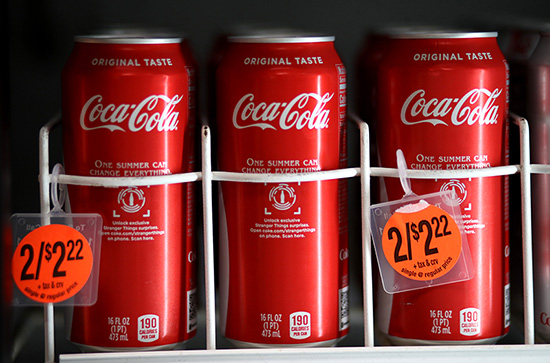百年老店专注夕阳产业,却受到投资者热捧,原因在于中国

|
这家公司度过了狂欢的一年。 Ball Corp.最近击败了经常霸榜的生物科技公司和科技公司,成为过去12个月内标普500指数中表现第二好的股票,而大多数消费者对这家公司的了解都是通过它曾经销售的Ball牌梅森杯间接获得的。 该公司已经有将近一个半世纪的历史了,它很早就加入了反对塑料的战争,现在控制着全球33%的金属罐市场份额。如今,敏感的市场情绪以及所谓健康饮料的繁荣让该公司从中受益。它在20世纪90年代剥离了水杯生产业务,现在铝包装业务是重中之重。 标普500指数过去12个月的回报率只有区区2%(原因之一是国际环境的变化),但Ball Corp.的股价却飙升了91%。 这家市值250亿美元的公司为百威英博啤酒集团(Anheuser-Busch InBev)和可口可乐(Coca Cola)等公司供货,过去12个月的投资回报率仅次于债券交易平台MarketAxess。 几年来,消费者出于对健康的担忧,对汽水和啤酒的需求一直在下降,这两种产品是饮料罐行业的存亡关键,因此拖累了Ball的股价。但尼尔森的数据显示,苏打水、即饮鸡尾酒和其他种类的饮料已经取而代之,2018年饮料销售额增长3%,达到560亿美元。 Ball公司 116亿美元的收入中约90%来自于饮料包装(另外10%来自于该公司的航空航天部门)。 “如果你在1986年走进一家便利店,货架上的瓶瓶罐罐可能会有不同的颜色。”研究公司Vertical Research Partners的合伙人奇普·狄龙说,“市面上有这么多饮料品牌,要让人们注意到你,你需要生产很多不同的尺寸和形状。第二,塑料已经变成了众矢之的,而最便宜的替代品是铝。” 以Liquid Death为例。今年5月,该公司在种子轮筹集了160万美元的资金,销售的罐装水不仅以滑稽的“硬核”形象出现,而且还强调金属比塑料更可持续。饮料罐上除了印着“杀死口渴”这样吸引眼球的口号,还印了“塑料终结者”的话题标签。标签上说,70%的铝罐是可回收的,可回收塑料瓶只有3%。 塑料战争 在2019年索恩投资大会上(Sohn Investment Conference),资本公司Diameter Capital Partners的斯科特·古德温表示,他正在做空Plastipak的无担保债券。Plastipak是一家为卡夫亨氏(Kraft Heinz)和宝洁(Proctor & Gamble)等公司提供硬质塑料包装的公司。 “塑料包装行业已经日薄西山。”他在今年5月表示。 早在很久之前,倡导者就开始警告消费者,塑料制品在海滩上堆积如山,但是,反对塑料制品的运动,特别是反对单一用途塑料制品的运动,却在今年的美国市场上掀起了轩然大波。 洛杉矶和温哥华等城市正在禁止或限制塑料吸管的使用,而星巴克、凯悦和希尔顿等大公司则计划缩减对塑料的使用。百事可乐表示,计划将阿夸菲纳(Aquafina)品牌的水装在铝罐里。过去,中国是回收世界上大量垃圾的垃圾场,却在2018年停止了此类进口,美国国内因此引发了一场垃圾危机。 投资者看到市场对塑料制品的抵制,因此押注于Ball的可持续发展。 Robert W. Baird & Co. Senior Research研究公司的高级研究分析师甘沙姆·潘贾比称:“过去几年,人们对气泡饮料、能量饮料和可持续的关注推动了(对饮料罐的)需求。” 这家铝罐制造商也投入了双倍赌注。为了解决目前每一间大学校园或户外场地都存在的一次性杯子问题,该公司计划推出可重复使用的铝杯。 摩根士丹利(Morgan Stanley)的分析师尼尔·库马尔在最近给投资者的一份报告中写道:“鉴于全球对一次性塑料制品的审查日益严格,我们认为铝杯(全球铝杯的潜在市场约为900亿件,美国约为300亿件)对Ball来说是一个重大的长期的机遇。” 这种势头还能继续吗? 从一种衡量标准来看,该股的市盈率为47倍,不便宜。2018年,这个数字是27。“这是一种趋势。” Vantagepoint Investment Advisers公司的首席投资官韦恩·威克指出,“该股是否容易受到回调的影响?这不是不可能的。” 此外,该股的上涨也不能完全归因于公司本身。对经济衰退的担忧也促使投资者更多地买入Ball等防御类股,这些股票的特点是增长稳定,波动性较低。标普500主要消费指数过去一年上涨了12%,该股指包括宝洁、可口可乐、百事可乐和沃尔玛等公司。 威克补充称:“地缘政治和对关税的担忧带来了更大的不确定性,其中许多因素给投资者对未来收益增长的预期蒙上了阴影。” 但就目前而言,看多情绪一直在推动Ball的股价上涨。(财富中文网) 译者:Agatha |
It’s had an absolute ball of a year. Ball Corp.—a company that most consumers only know obliquely through the Ball-branded mason jars it once sold, beat out biosciences and tech companies that have often dominated the rankings recently to become the second best performing stock on the S&P 500 index over the past 12 months. Nearly a century-and-a-half old, Ball enter the war against plastic early, and now controls about 33% of the global market share for metal cans. And now, that, combined with jittery markets and a boom in so-called healthier beverage choices have benefitted the company, which spun off its jar business in the 1990s and now runs an aluminum packaging business as its crown jewel. While the S&P 500 index returned a paltry 2% over the past 12 months in part due to escalating trade war tensions, shares of Ball Corp. have soared 91%. The $25 billion company by market capitalization, that serves the likes of Anheuser-Busch InBev and Coca Cola, ranks just behind MarketAxess, a bond trading platform, in terms of returns over the past 12 months. For several years, consumer demand for the bread and butter of the industry—soda and beer—had been declining due to health concerns and dragged on the Ball’s shares. But seltzers, ready-to-drink-cocktails and other options have taken their place, boosting beverage sales 3% to $56 billion in 2018, per Nielsen’s data. Roughly 90% of Ball’s $11.6 billion revenue comes from beverage packaging (the other 10% comes from the company's aerospace unit). “If you went into a convenience store in 1986, the bottles and cans maybe had different colors,” said Chip Dillon, a partner at Vertical Research Partners. “With the number of beverage brands out there, to get people to notice you, you need many different sizes and shapes. Number two, plastics have become the bad guys—and the cheapest alternative to plastic is aluminum.” Take Liquid Death for example. In May, the company raised $1.6 million in seed funding and sells canned water branded not only to appear comically “hardcore,” but also to emphasize how metal is more sustainable than plastic. Alongside the catch phrase “murder your thirst,” the can also features the hashtag, “DeathToPlastic.” While 70% of an aluminum can is recyclable, the label claims, just 3% of a plastic bottle are. War on plastic At the 2019 Sohn Investment Conference, Diameter Capital Partners’ Scott Goodwin said he’s shorting the unsecured bonds of Plastipak, a company that provides rigid plastic packaging to the likes of Kraft Heinz and Proctor & Gamble. “The sun is setting on the age of plastic packaging,” he said in May. Advocates have long warned consumers of plastic build up in beaches—but the movement against plastic, especially of the single-use variety, hit the U.S. market full force this year. Cities including Los Angeles and Vancouver are in the process of banning or restricting the use of plastic straws, while major companies including Starbucks, Hyatt, and Hilton plan to shrink their plastic footprint. Pepsi said it plans to serve Aquafina-brand water in aluminum cans. China, which was the dumping ground for much of the world’s recycling in the past, ended such imports in 2018 and, in the process, created a trash crisis stateside. Seeing a pushback against plastic, Ball has been a bet on sustainability for some investors. “In the last couple years, (demand for cans) has been propagated by interest in sparkling, energy drinks, and sustainability concerns,” said Robert W. Baird & Co. Senior Research Analyst Ghansham Panjabi. The can maker is also doubling down. In an answer to red solo cups now native to any college campus or cookout, the company plans to release reusable aluminum cups. “Given the increasing global scrutiny on single serve plastics, we believe aluminum cups (addressable market of about 90 billion units globally, about 30 billion units U.S.) represent a substantial long term opportunity for Ball,” wrote Morgan Stanley analyst Neel Kumar in a recent note to investors. Can the run continue? By one measure, the stock is expensive with a price-to-earnings ratio is at a 47 times earnings. In 2018, that figure was 27. “That is a run,” notes Wayne Wicker, Chief Investment Officer with Vantagepoint Investment Advisers. “Is the stock vulnerable to a pull back? It’s not outside the realm of possibility.” Moreover, the stock’s rise can’t entirely be attributed to the company. Recession fears have also pushed investors into defensives stocks like Ball, that feature steady growth and low volatility. The S&P 500 Consumer Staples Index, which includes the likes of Procter & Gamble, Coca-Cola, Pepsi, and Walmart, has risen 12% in the past year. “There’s been greater uncertainty with some geopolitical and tariff concerns, many of those things clouded investors outlooks in terms of future earnings growth,” added Wicker. But for now, the bulls have kept the Ball rolling. |













